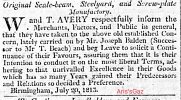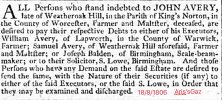Pedrocut
Master Barmmie
How long was avery here? It was a big building
Messrs W and T Avery, were at Digbeth Since at least 1833.
How long was avery here? It was a big building



1779 is going back an awful long time, how interestingHere we have Mr Beach operating in the Bull Ring in 1779 as a scale beam and steelyard maker, clearly an established business if he’s buying up Brunton’s branches. Pity it doesn’t confirm where exactly in the Bull Ring but most probably the Digbeth address given earlier.
Viv
View attachment 176180
Source: British Newspaper Archive
Was 12 Digbeth just the showroom for W&T Avery then?Note on the map for southern side of Digbeth the W and T Avery repair shop was in Moat Lane.
On closer look Avery are possibly on both sides of Moat Lane repairing shop. There is a coppersmith next door and another on Digbeth( subcontractors?). Lots of vacant properties there too so easy to expand.It could be, they are listed early as 11, then 12 and a half, and also 12A. On the map 12 seems a bit larger than the other premises so they could have expanded from the early days ?

Me too. I’ve been in the Australian Outback looking at gold weighing scales for miners made by Avery. TinpotPosted at the same time Tinpot !
If like me you’ve been thinking a ‘steelyard’ was a yard for storing steel, it isn’t ! I’d been looking for evidence of a largish yard on maps only to realise a steelyard is a :
balance in which an object to be weighed is suspended from the shorter arm of a lever and the weight determined by moving a counterpoise along a graduated scale on the longer arm until equilibrium is attained.
I’ve leaned something new. Viv

